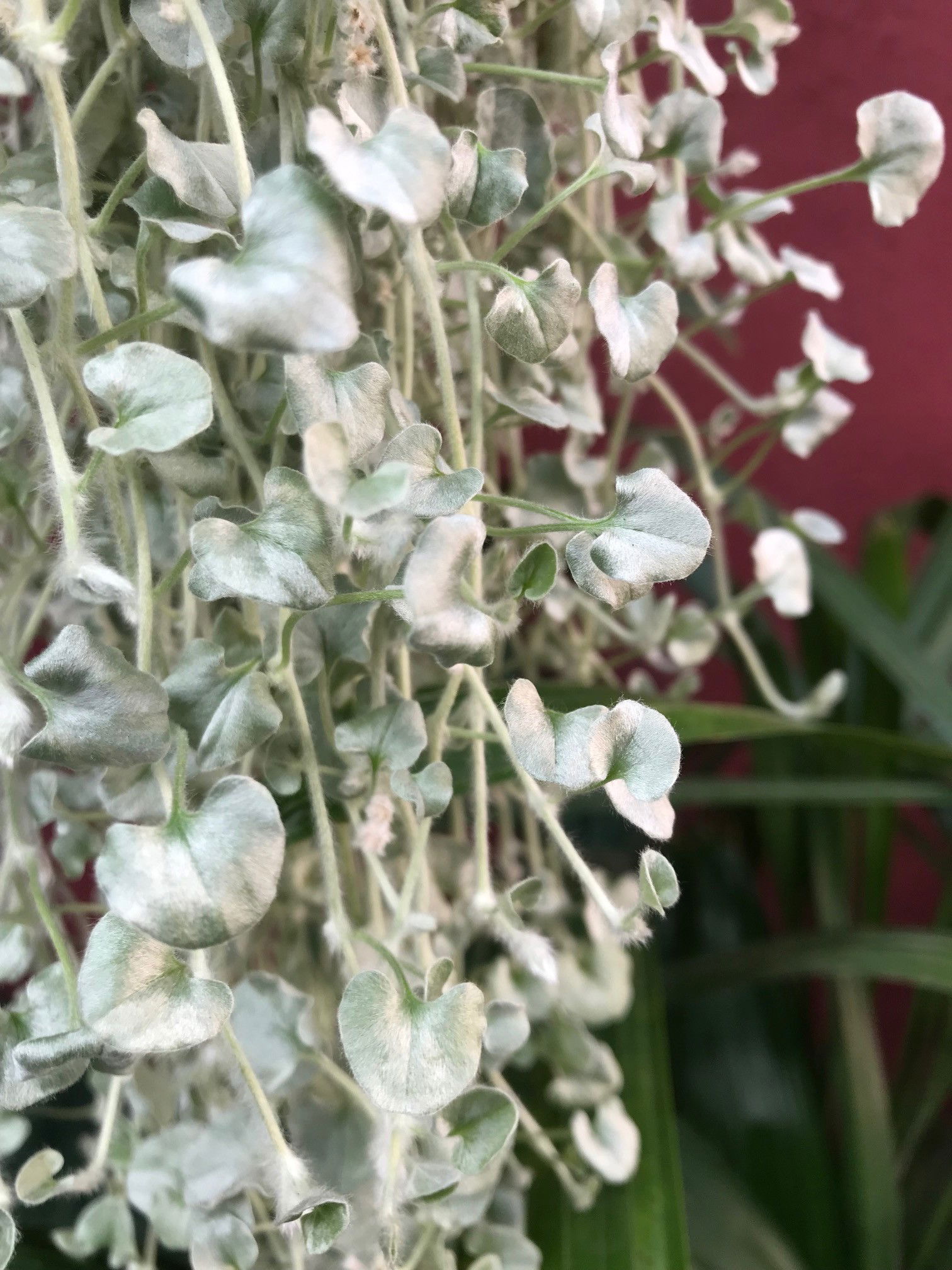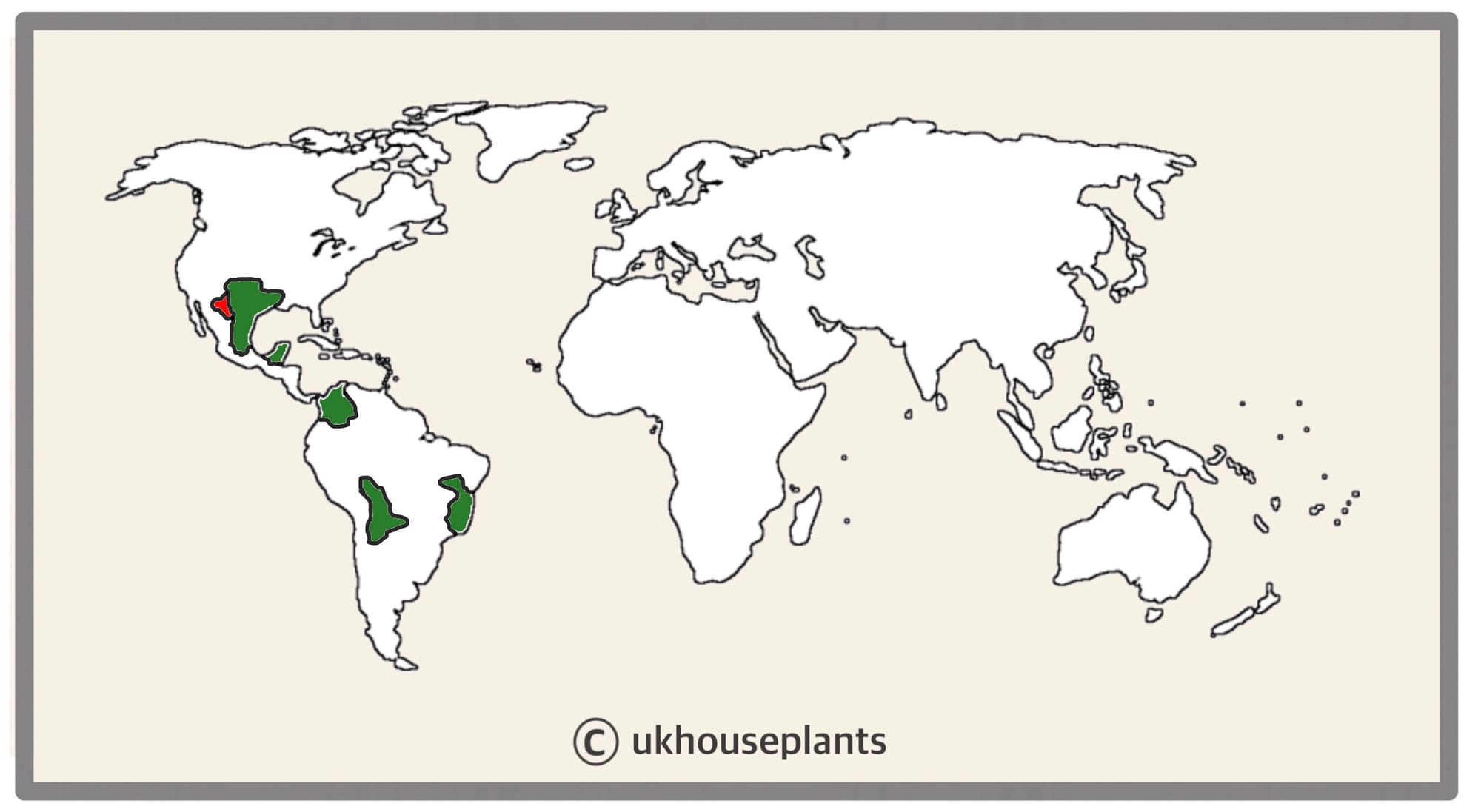
Dichondra argentea 'Silver Falls'
Contents
- Top Tips
- Location, Water, Humidity & Fertilisation
- Common Issues
- Origins, Temperature, Propagation, Repotting & Toxicity.
Need the answer to a specific plant query? Book a 1-to-1 video call with THE HOUSEPLANT DOCTOR™, the website's friendly author, to overcome and address your niggling problem! Available on iMessage, WhatsApp, Facebook Messenger & more.
Top Tips & Info
- Care Difficulty - Easy
- Bright, indirect light is best, but offering a few hours of morning or evening sun is highly beneficial.
- Keep the soil evenly moist, allowing the pot to feel light in between waters. It's advised to hydrate the plant using the bottom-up method of submersion, for the prevention of rotting foliage (caused by prolonged moisture on the leaves).
- Fertilise using a 'Houseplant' labelled feed every four waters in the spring and summer, reducing this to every six in the colder months.
- In spring, repot every three years with a 'Houseplant' labelled compost. Water the plant 24hrs beforehand, to reduce the risk of damaging the root hairs, otherwise known as Transplant shock.
Location & Light - 🔸🔸🔸
Provide a bright location that offers a few hours of either morning or evening sun. A shady will significantly increase the chance of root-rot, as well as much slower growth. The ideal location around the house would be within a few metres of a window or in a semi-shaded conservatory.
Water - 🔸🔸
Dichondra are well-equipped to endure short-lived droughts - which is why they're used in sunny hanging baskets. Once the pot begins to feel light again, rehydrate the soil using the bottom-up method of submersion. Place the plant on a saucer and fill the bottom 25% with lukewarm water; it should only take a few minutes for full absorption. Never allow excess moisture to sit on the foliage as it could cause rotting foliage or even powdery mildew. Under-watering symptoms include the curling or crisping of leaves, yellowed foliage, stunted growth and a 'washed out' appearance. These issues are usually caused by too little soil moisture and too much light/heat. Although they prefer to be kept on the drier side to life, poor soil conditions will increase the chance of dehydration and disease susceptibility. Over-watering will create leaf-loss at the base (leaves closest to the soil), root rot, and possible stem collapse. These are usually down to too much soil moisture - be sure to allow at least half of the soil dry out in between waterings and consider a brighter location, too.
Humidity - 🔸
High humidity isn't required for Dichondra; however, misting the leaves during hot spells will help keep them hydrated as long as it's not in direct sunlight. Over-misting the foliage could cause several fungal issues down the line, like powdery mildew or leaf spot disease, especially if it's grown in a shady location.
Fertilisation - 🔸
Fertilise every four waters during the growing period before reducing this to every six in the autumn & winter. Although an 'All-Purpose' fertiliser will still do the job, we'd recommend using a specific 'Houseplant' labelled fertiliser as it'll support the vital thirteen nutrients that this species will need to grow.
Common Issues with Dichondra
Root rot is the biggest issue. Typical symptoms include rapidly yellowing leaves, stunted growth and stem collapse. Those situated in darker locations and/or too-soggy soil are most likely to be hit with this issue. Take the plant out of the pot and inspect its root systems - if they sport a yellow appearance, you're okay, but if they're brown and mushy, action must be taken immediately. More information about addressing root rot can be found on this link.
Yellowing leaves or a naked base are products of excess moisture being allowed to sit on the foliage, commonly sped up by too little light or poor air circulation. Although watering from the top is best, it's recommended to use the bottom-up method if you're a messy waterer. For specimens that have a bare head, improve growing contains by using this method and increasing light levels slightly. Promote a bushier appearance by taking vine cuttings and placing them halfway down into the soil. Immediately remove yellowed or rotten debris as this will harbour both bacterial and fungal diseases that can both spread across to other sections of the plant.
Never situate it within four metres of an operating heat source, for instance a radiator or fireplace. Due to the heightened temperature, the plant will soak up far more moisture than those situated in cooler locations, increasing the chance of droughts and browning leaf-edges.
Too much sunlight will lead to sun scorch, with typical signs including the browning or crisping of leaves, dry leaf-edges, sunken leaves or stunted growth. Although too little light will cause over-watering issues, too much sunlight will be a detriment, too. If yours has fallen short of this, reduce the amount of sunlight considerably and always be mindful of environmental shock (when too locations offer too different growing conditions). Remove some of the affected leaves and increase waters slightly.
As mentioned before, Powdery Mildew and Southern Blight are major threats among heavy foliage plants when excess moisture is allowed to sit on compacted foliage. Remove the affected areas and improve the growing conditions by situating the plant in a brighter location and keeping the leaves dry.
Origins
The genus of Dichondra was first described back in the 1780s by Georg & Johann Forster. For those who don't know who these explorers are, they accompanied Captain Cook during his Second Voyage to the Pacific and took notes of the yet-to-be-discovered Kentia Palms and Norfolk Island Pines. Its name derives from Ancient Greek meaning 'two' and 'grains', which is in reference to the fruits produced in the autumn. The species, D. argentea, originates from several locations of North and South America, first being described botanically by Carl Ludwig Willdenow in the 1800s. The specific epithet can be translated from Latin, referring to its silver-like appearance.
 The Distribution of Dichondra argentea in Green & locations where it has become extinct in Red (The State of Arizona).
The Distribution of Dichondra argentea in Green & locations where it has become extinct in Red (The State of Arizona).
Temperature
5° - 30°C (41° - 86°F)
H2 (Hardiness Zone 10) - Tolerant of temperatures above freezing. This plant will die if left in temperatures below frosts; move to a conservatory or greenhouse until this risk has elapsed.
Spread
Up to 15cm in height and 2m in width, with the ultimate height being reached in 2 - 4 years.
Pruning
Remove yellow or dying leaves, and plant debris to encourage better-growing conditions. While pruning, always use clean utensils or shears to reduce the chance of bacterial and fungal diseases. Never cut through yellowed tissue as this may cause further damage in the likes of diseases or bacterial infections. Remember to make clean incisions as too-damaged wounds may shock the plant, causing weakened growth and a decline in health.
Propagation
Via Seed or Vine Cuttings.
Vine Cuttings
- Choose the healthiest, most established vines from the leading growths. This propagation method can be taken from spring to summer, using between three to six leaves, with the vine being at least 8cm (3 inches) in length.
- Cut directly below a node (leaf), using a clean pair of scissors to reduce bacteria count.
- Use a 5 inch pot that has good drainage holes - plastic or terracotta are both acceptable in this instance.
- Set the cutting into moist 'Houseplant' labelled compost, keeping the foliage above the soil line. Be sure to submerge the bottom node into the soil, or else its root development will be hindered.
- Avoid direct sunlight and offer good humidity by placing the potted plants into a transparent plastic bag for the first couple of weeks. Keep the soil evenly moist almost all of the time.
- Open the bag every two days for half an hour for the prevention of disease. After a month of being placed in soil, remove it from the bag and treat as an ordinary houseplant.
Flowers
Dichondra will produce small clusters of white flowers along the leading growths in the summer months. Unfortunately, due to the unfavored growing conditions indoors, they'll rarely flower when domestically cultivated and therefore are predominantly grown for their foliage.
Repotting
Repot every two years in the spring, using a 'Houseplant' labelled potting mix and the next sized pot with adequate drainage. Dichondra are far better potbound for several years due to the heightened risk of root rot and repotting-issues (like transplant shock), so only repot if you feel it's wholly necessary - restricted root growth will also increase the chance of blooms, too.
Hydrate the plant 24hrs before tinkering with the roots to prevent the risk of transplant shock. For those situated in a darker location, introduce an extra amount of perlite and grit into the deeper portion of the pot to downplay over-watering risks. Click on this link for a detailed step-by-step guide on transplantation, or via this link to learn about repotting with root rot.
Book a 1-to-1 video call with Joe Bagley if you'd like a personal guide to repotting your houseplant. This will include recommending the right branded-compost and pot size, followed by a live video call whilst you transplant the specimen for step-by-step guidance and answer any further questions!
Pests & Diseases
Keep an eye out for mealybugs, aphids, scale, fungus gnats, whitefly, blackfly, vine weevils & root mealybugs that'll locate themselves in the cubbyholes and undersides of the leaves, with the exception of the latter two in the soil. Common diseases associated with Dichondra are root rot, leaf-spot disease, botrytis, rust, powdery mildew & southern blight - click here to learn more about these issues.
Toxicity
This plant is classified as poisonous. If sections are eaten, vomiting, nausea and a loss of appetite could occur. Consumption of large quantities must be dealt with quickly; acquire medical assistance for further information.
Retail Locations
Some garden centres will sell this outside in the hanging basket selection during the spring - mainstream stores are Dobbies & Blue Diamond.
Book a 1-to-1 Call with THE HOUSEPLANT DOCTOR™
If you need further advice with your houseplants, book an advice call with ukhouseplants' friendly and expert writer today! This can be done via a video or audio call on most apps, including Facebook, FaceTime & Skype. A ten-minute call costs £5.99 (US$7), or £15.99 for thirty minutes. You can ask multiple questions, including queries on plants, pests, terrariums, repotting advice and anything in between. Please consider supporting this service to keep ukhouseplants thriving!